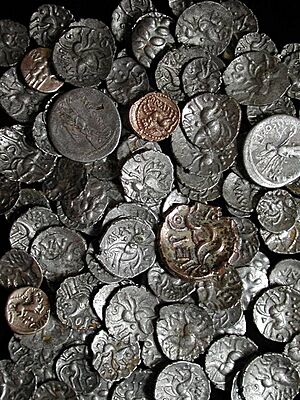Hallaton Treasure facts for kids
The Hallaton Treasure is the biggest collection of British Iron Age coins ever found! It was discovered in 2000 near Hallaton in southeast Leicestershire, England. Volunteers from the Hallaton Fieldwork Group found it. Ken Wallace made the first exciting discovery on November 19, 2000. He used a metal detector and found about 130 coins.
Local archaeologists worked with the University of Leicester Archaeological Services (ULAS). Together, they dug up what became one of Britain's most important Iron Age sites. This project also involved the local community, making it a special discovery.
Contents
What Was Found in the Hallaton Treasure?
The Hallaton Treasure is a huge collection of ancient items. It includes more than 5,000 silver and gold coins. There was also a beautiful silver-gilt Roman parade helmet. Other items like jewellery were found too. Most of these objects are from around the 1st century AD. This was when the Romans took over Britain.
Ancient Coins and Their Story
Out of all the coins, 4,835 belonged to a local tribe called the Corieltauvi. This amazing find more than doubled the total number of Corieltauvian coins known before! It tells us a lot about this ancient tribe.
One silver Roman coin from the treasure is very special. Museums have dated it to 211 BC. This makes it the oldest Roman coin ever found in Britain! Some experts think this coin arrived in Britain before the Roman conquest in 43 AD. It might show that people traded or had diplomatic ties with the Roman Empire.
A Special Ancient Site
The place where the treasure was found was also very important. It was a ritual site, used for special ceremonies. Most of its use was just before and after the Roman Conquest. Archaeologists believe it was an open-air shrine. This is the first time such a shrine has been found in the UK. It was on a hilltop in the Welland valley. It was probably surrounded by a ditch and a fence.
Professor David Mattingly, an archaeologist from the University of Leicester, said something important about the find. He explained that this treasure changed how we see the East Midlands during that time. It shows that this region had contact with the Roman Empire. This was true even though it was far from where the Romans first arrived in Britain.
The Hallaton Treasure on Display
You can see many items from the Hallaton Treasure at the Harborough Museum. The Roman Hallaton Helmet spent nine years being carefully preserved. Experts at the British Museum worked on it. In 2012, it finally went on display at the Harborough Museum.
In 2011, it was announced that the skeleton of a dog would also be displayed. People believe this dog was sacrificed to protect the treasure.
The Mystery of the TOT Ring
In 2012, a silver ring was found in the same area. It had the word "TOT" carved into it. Experts think "TOT" refers to the Celtic god Toutatis. This god is similar to the Roman god Mars. Adam Daubney, an expert on these rings, suggests that Toutatis might have been worshipped at Hallaton. The Leicestershire County Council bought the ring. It is now also on display at the Harborough Museum.


